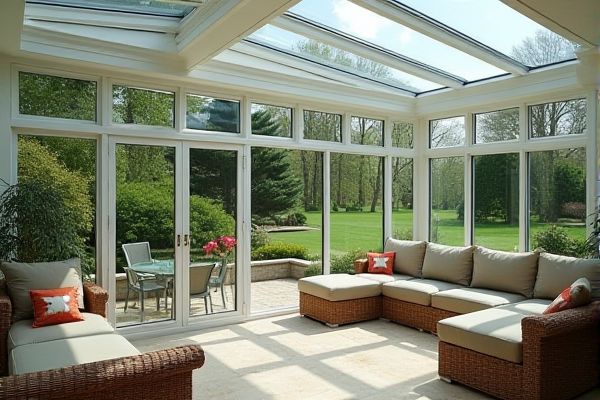
Tempered glass offers high clarity and superior scratch resistance, making it an excellent choice for sunrooms seeking a sleek, elegant look, while polycarbonate provides exceptional impact resistance and insulation, ideal for areas prone to extreme weather or safety concerns. Discover which material best suits Your sunroom needs by exploring the detailed comparison in the rest of this article.
Table of Comparison
| Feature | Tempered Glass | Polycarbonate |
|---|---|---|
| Material Type | Heat-treated glass | Transparent thermoplastic |
| Strength | 4-5 times stronger than regular glass | Up to 250 times impact resistant than glass |
| Weight | Heavier | Lightweight, about half the weight of glass |
| UV Protection | Moderate UV filtering | High UV resistance with UV coating |
| Transparency | High clarity and brilliance | Good clarity, slight yellow tint possible over time |
| Thermal Insulation | Moderate | Better insulator due to air gap options |
| Cost | Higher price | More cost-effective |
| Safety | Shatters into small granular pieces | Does not shatter, flexible and impact resistant |
| Installation | Requires careful handling, heavier support needed | Easier to handle and install, flexible |
| Lifespan | 15-25 years depending on conditions | 10-15 years with proper maintenance |
Introduction to Sunroom Glazing Materials
Tempered glass and polycarbonate are two popular sunroom glazing materials known for their durability and light transmission. Tempered glass offers superior clarity, scratch resistance, and heat retention, making it ideal for enhancing your sunroom's aesthetic and energy efficiency. Polycarbonate provides excellent impact resistance and UV protection while being lighter and more flexible, suitable for areas prone to hail or strong winds.
What Is Tempered Glass?
Tempered glass is a type of safety glass processed by controlled thermal or chemical treatments to increase its strength compared to normal glass. It is designed to shatter into small, blunt pieces rather than sharp shards, reducing injury risk in sunroom applications. This durability and safety make tempered glass a popular choice for sunroom windows and doors, providing enhanced resistance to impacts and thermal stress.
What Is Polycarbonate?
Polycarbonate is a durable, lightweight thermoplastic known for its high impact resistance and excellent transparency, making it ideal for sunrooms where safety and light transmission are priorities. Unlike tempered glass, polycarbonate sheets are more flexible and resistant to shattering, providing enhanced protection against extreme weather conditions. Your sunroom benefits from polycarbonate's UV-resistant coating, which helps reduce heat buildup while maintaining clear visibility.
Durability: Tempered Glass vs Polycarbonate
Tempered glass offers exceptional scratch resistance and withstands high impact, making it highly durable for long-term sunroom installations. Polycarbonate provides superior impact resistance and flexibility, reducing the risk of shattering under extreme weather conditions. While tempered glass excels in hardness and clarity, polycarbonate's lightweight nature and resistance to cracking enhance overall durability in dynamic environments.
Insulation and Energy Efficiency Comparison
Tempered glass offers superior thermal insulation with high solar heat gain coefficients, helping maintain warmer temperatures in your sunroom during colder months while reducing energy costs. Polycarbonate provides excellent UV protection and superior impact resistance but tends to have lower insulation properties, potentially leading to higher heating and cooling expenses. Choosing tempered glass enhances energy efficiency by minimizing heat loss and maximizing natural light transmission for a comfortable sunroom environment.
Light Transmission and Clarity Differences
Tempered glass offers superior light transmission and clarity, providing a crystal-clear view with minimal distortion, ideal for sunrooms where natural illumination is a priority. Polycarbonate, while durable and impact-resistant, tends to have slightly lower light transmission and may exhibit a subtle haze or yellowing over time, affecting the clarity of your sunroom's appearance. Choosing tempered glass ensures maximum brightness and visual sharpness for your sunroom environment.
Safety Considerations for Sunrooms
Tempered glass offers high resistance to impact and shatters into small, blunt pieces, reducing injury risk in sunrooms. Polycarbonate is more impact-resistant and virtually unbreakable, making it ideal for areas prone to severe weather or potential impacts. Choose the material that best protects your sunroom's occupants based on your safety needs and environmental conditions.
Maintenance and Longevity Analysis
Tempered glass offers superior scratch resistance and maintains clarity over time, requiring minimal cleaning with standard glass cleaners; however, it is prone to shattering under severe impact, which affects its longevity. Polycarbonate panels boast exceptional impact resistance and durable performance in harsh weather, but they may scratch more easily and require regular cleaning with non-abrasive solutions to preserve transparency. Both materials provide long-term benefits for sunrooms, with tempered glass excelling in clarity and scratch resistance, while polycarbonate offers enhanced durability and impact tolerance.
Cost Comparison: Initial and Long-Term
Tempered glass for sunrooms generally has a higher initial cost, averaging $12 to $18 per square foot, compared to polycarbonate panels, which range from $6 to $12 per square foot. Long-term expenses show tempered glass excels in durability and scratch resistance, reducing replacement frequency, while polycarbonate may require more frequent maintenance and eventual replacement due to yellowing and impact damage. Energy efficiency ratings also affect overall cost-effectiveness, with tempered glass offering better insulation that can lead to lower heating and cooling bills over time.
Choosing the Best Material for Your Sunroom
Tempered glass provides excellent clarity, durability, and scratch resistance, making it ideal for sunrooms seeking maximum natural light and longevity. Polycarbonate offers superior impact resistance and lightweight performance, ensuring safety and durability in areas prone to storms or high-impact events. Your choice depends on whether you prioritize optical clarity or enhanced strength and flexibility for your sunroom.
 homyna.com
homyna.com